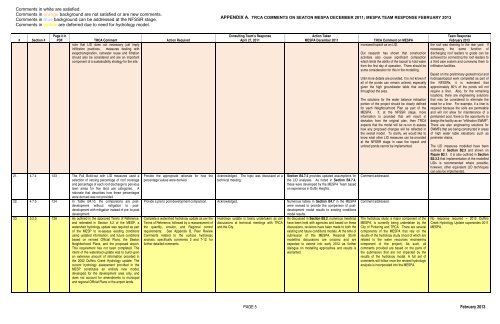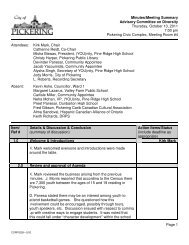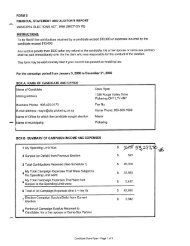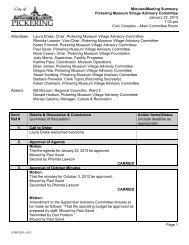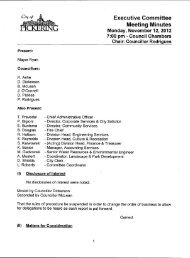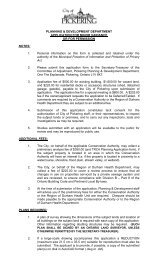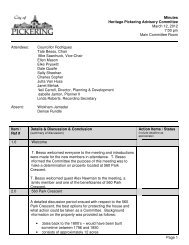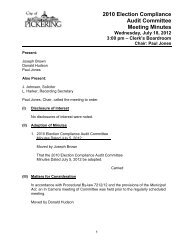Chapter A - Introduction - City of Pickering
Chapter A - Introduction - City of Pickering
Chapter A - Introduction - City of Pickering
You also want an ePaper? Increase the reach of your titles
YUMPU automatically turns print PDFs into web optimized ePapers that Google loves.
Comments in white are satisfied.<br />
Comments in orange background are not satisfied or are new comments.<br />
Comments in blue background can be addressed at the NFSSR stage.<br />
Comments in yellow are deferred due to need for hydrology model.<br />
APPENDIX A. TRCA COMMENTS ON SEATON MESPA DECEMBER 2011; MESPA TEAM RESPONSE FEBRUARY 2013<br />
# Section #<br />
Page # in<br />
PDF TRCA Comment Action Required<br />
note that LID does not necessary just imply<br />
infiltration practices, measures dealing with<br />
evapotranspiration, rainwater reuse and filtration<br />
should also be considered and are an important<br />
component <strong>of</strong> a sustainability strategy for the site.<br />
21. 4.7.4 123 The Full Build-out with LID measures used a<br />
selection <strong>of</strong> varying percentage <strong>of</strong> ro<strong>of</strong> coverage<br />
and percentage <strong>of</strong> each ro<strong>of</strong> discharge to pervious<br />
lawn areas for five land use categories. A<br />
rationale that describes how these percentages<br />
were derived was not provided.<br />
22. 4.7.5 124 In Table B4.10, the comparisons are postdevelopment<br />
without mitigation to postdevelopment<br />
with mitigation instead <strong>of</strong> pre- to post<br />
development.<br />
23. 5.2.3 128 As outlined in the approved Terms <strong>of</strong> Reference,<br />
and reiterated in Section 5.2 <strong>of</strong> the MESP, a<br />
watershed hydrology update was required as part<br />
<strong>of</strong> the MESP to re-assess existing conditions<br />
using updated information, and future conditions<br />
based on revised Official Plans, the Seaton<br />
Neighborhood Plans, and the proposed airport.<br />
This requirement has not been completed. The<br />
intent <strong>of</strong> the watershed update was to build upon<br />
an extensive amount <strong>of</strong> information provided in<br />
the 2002 Duffins Creek Hydrology update. The<br />
current hydrology assessment provided in the<br />
MESP constitutes an entirely new model,<br />
developed for the development area only, and<br />
does not account for amendments to municipal<br />
and regional Official Plans or the airport lands.<br />
Provide the appropriate rationale for how the<br />
percentage values were derived.<br />
Consulting Team’s Response<br />
April 27, 2011<br />
Acknowledged. The topic was discussed at a<br />
technical meeting.<br />
Action Taken<br />
MESPA December 2011<br />
Section B4.7.4 provides updated assumptions for<br />
the LID analyses. As noted in Section B4.7.4,<br />
these were developed by the MESPA Team based<br />
on experience in Duffin Heights.<br />
Provide a pre to post-development comparison. Acknowledged. Numerous tables in Section B4.7 in the MESPA<br />
were revised to provide the comparison <strong>of</strong> postdevelopment<br />
model results to existing conditions<br />
model results.<br />
Complete a watershed hydrology update as per the<br />
Terms <strong>of</strong> Reference, followed by a reassessment <strong>of</strong><br />
the quantity, erosion, and Regional control<br />
requirements. See Appendix B, Peer Review<br />
Comments related to the surface hydrologic<br />
analysis, specifically comments 2 and 7-12, for<br />
further detailed comments.<br />
Hydrology update is being undertaken as per<br />
discussions at technical meetings with TRCA<br />
and the <strong>City</strong>.<br />
As discussed in Section B5.2, numerous meetings<br />
have been held with agencies and based on these<br />
discussions, revisions have been made to both the<br />
existing and future conditions models. At the time <strong>of</strong><br />
submission <strong>of</strong> this MESPA, Regional Storm<br />
modelling discussions are ongoing and are<br />
expected to extend into early 2012 as further<br />
dialogue on modelling approaches and results is<br />
warranted.<br />
TRCA Comment on MESPA<br />
increased topsoil as an LID.<br />
Our research has shown that construction<br />
activities also cause significant compaction<br />
which limits the ability <strong>of</strong> the topsoil to hold water<br />
from the first day <strong>of</strong> operation. There should be<br />
some consideration for this in the modelling.<br />
Until more details are provided, it is not known if<br />
all <strong>of</strong> the ponds can remain unlined, especially<br />
given the high groundwater table that exists<br />
throughout the area.<br />
The solutions for the water balance mitigation<br />
portion <strong>of</strong> the project should be clearly defined<br />
for each Neighbourhood Plan as part <strong>of</strong> the<br />
MESPA. If, at the NFSSR stage, more<br />
information is provided that will result in<br />
deviation from the original plan, then TRCA<br />
expects that the model will be re-run to assess<br />
how any proposed changes will be reflected in<br />
the overall model. To clarify, we would like to<br />
know what other LID measures can be provided<br />
at the NFSSR stage in case the topsoil and<br />
unlined ponds cannot be implemented.<br />
Comment addressed.<br />
Comment addressed.<br />
The hydrology study; a major component <strong>of</strong> the<br />
MESPA, is currently being undertaken by the<br />
<strong>City</strong> <strong>of</strong> <strong>Pickering</strong> and TRCA. There are several<br />
components <strong>of</strong> the MESPA that rely on the<br />
results <strong>of</strong> the hydrology study (most <strong>of</strong> which are<br />
related to the water resources engineering<br />
component <strong>of</strong> the project). As such, all<br />
comments provided are based on the parts <strong>of</strong><br />
the submission that are not impacted by the<br />
results <strong>of</strong> the hydrology model. A full set <strong>of</strong><br />
comments will follow once the revised hydrologic<br />
analysis is incorporated into the MESPA.<br />
Team Response<br />
February 2013<br />
the ro<strong>of</strong> was draining to the rear yard. If<br />
necessary, the same function <strong>of</strong><br />
discharging ro<strong>of</strong> leaders to grade can be<br />
achieved by connecting the ro<strong>of</strong> leaders to<br />
a third pipe system and conveying them to<br />
infiltration facilities.<br />
Based on the preliminary geotechnical and<br />
hydrogeological work completed as part <strong>of</strong><br />
the NFSSRs, it is estimated that<br />
approximately 80% <strong>of</strong> the ponds will not<br />
require a liner. Also, for the remaining<br />
locations, there are engineering solutions<br />
that may be considered to eliminate the<br />
need for a liner. For example, if a liner is<br />
required because the soils are permeable<br />
and will not allow for maintenance <strong>of</strong> a<br />
permanent pool, there is the opportunity to<br />
design the facility as an “infiltration SWMF”.<br />
There are also engineering solutions for<br />
SWMFs that are being constructed in areas<br />
<strong>of</strong> high water table elevations such as<br />
perimeter drains.<br />
The LID measures modelled have been<br />
outlined in Section B2.3 and shown on<br />
Figure B2.1. It is also outlined in Section<br />
B2.3.3 that implementation <strong>of</strong> the modelled<br />
LIDs is recommended where possible;<br />
however, other equivalent LID techniques<br />
can also be implemented.<br />
No response required – 2012 Duffins<br />
Creek Hydrology Update supersedes 2011<br />
MESPA.<br />
PAGE 5 February 2013


